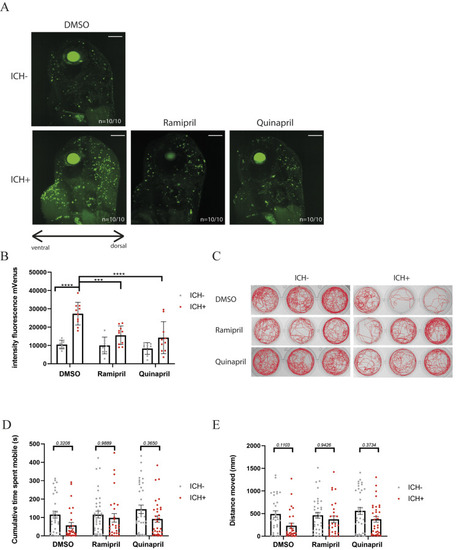
Angiotensin-converting enzyme inhibitor (ACE-I) treatment offers cellular neuroprotection but does not translate to functionality in zebrafish. (A) Representative images of annexinV expression in the brain at 72 h post-fertilisation (hpf) in DMSO-treated ICH− and ICH+ controls compared to ICH+ individuals that have been treated with ACE-I (n=10). (B) annexinV expression in the brain 24 h after ICH is significantly increased in DMSO vehicle-treated larvae, as previously observed in this model (***P=0.0003, ****P<0.0001) (Crilly et al., 2018; Crilly et al., 2019). Data (from n=10 larvae from three technical repeats) were analysed using a two-way ANOVA and Tukey's post hoc analysis. (C) Representative swimming traces for (n=3/24) larvae from each group, tracked over 10 min for spontaneous movement in response to a white-light stimulus every 1 min. Data presented from two technical repeats (clutches). (D,E) Functional analysis of spontaneous locomotion 72 h after ICH (120 hpf) shows an increase in time spent moving (D) and distance moved (E) in ramipril- and quinapril hydrochloride-treated ICH+ groups compared to DMSO vehicle-treated ICH+ groups, although these differences were not significant (P-values shown on graph). Data were analysed using mixed linear modelling and chi-squared test for non-parametric data. No significant difference between DMSO ICH+ and treatment ICH+ groups was observed (P=0.6); however, the data trend suggests that ICH+ treatment group values are closer to the ICH− treatment group values, highlighted by the increase in P-values presented on the graph. Scale bars: 100 μm.
|